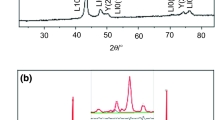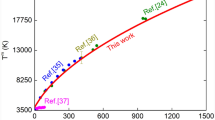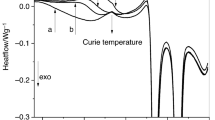Abstract
Sintered zirconium carbide (C/Zr ≈ 0.95) was studied by pulsed electrical heating method with microsecond duration. Thermophysical properties such as Joule energy, heat of melting, the specific heat, and electrical resistance were measured in the temperature range of 2500–5000 K by this method for the first time. The steep increase of the specific heat just before melting may be associated with the formation of nonequilibrium pairs point Frenkel defects at high temperatures under fast heating. It was established that the melting of the carbide occurs in the temperature range: solidus—3450 K and liquidus—3850 K, that is close to the values presented in some equilibrium phase diagrams of the system Zr–C. This means that there is no shift of the phase transition points at the heating rates up to 108 K/s, and makes it possible to use this method for the study of high temperature behavior of the complex substances. The comparison of the data of measured properties with the literature data is provided.








Similar content being viewed by others
References
H.F. Jackson and W.E. Lee: Properties and characteristics of ZrC. In Comprehensive Nuclear Materials, H.F. Jackson, ed. (Elsevier Ltd, London, 2012); pp. 339–369.
Y. Katoh, G. Vasudevamurthy, T. Nozawa, and L.L. Snead: Properties of zirconium carbide for nuclear fuel applications. J. Nucl. Mater. 441, 718 (2013).
A.F. Guillermet: Analysis of thermochemical properties and phase stability in the zirconium-carbon system. J. Alloys Compd. 217, 69 (1995).
H.F. Jackson, D.D. Jayaseelan, W.E. Lee, M.J. Reece, F. Inam, D. Manara, C. Perinetti-Casoni, F. De Bruycker, and K. Boboridis: Laser melting of spark plasma-sintered zirconium carbide: Thermophysical properties of a generation IV very high-temperature reactor material. Int. J. Appl. Ceram. Technol. 7(3), 316 (2010).
H.F. Jackson, D.D. Jayaseelan, D. Manara, C. Perinetti-Casoni, and W.E. Lee: Laser melting of zirconium carbide: Determination of phase transitions in refractory ceramic systems. J. Am. Ceram. Soc. 94(10), 3561 (2011).
D. Manara, H.F. Jackson, C. Perinetti-Casoni, K. Boboridis, M.J. Welland, L. Luzzi, P.M. Ossi, and W.E. Lee: The ZrC–C eutectic structure and melting behaviour: A high-temperature radiance spectroscopy study. J. Eur. Ceram. Soc. 33, 1349 (2013).
A.I. Savvatimskiy and S.V. Onufriev: Method and apparatus for studying high-temperature properties of conductive materials in the interests of nuclear power engineering. Phys. At. Nucl. 79(14), 1 (2016).
S.V. Onufriev, A.I. Savvatimskiy, and A.M. Kondratyev: Tantalum melting temperature under fast (microseconds) heating: Overheating is not found. High Temp.–High Pressures 43, 217 (2014).
A.M. Knyazkov, S.D. Kurbakov, A.I. Savvatimskiy, M.A. Sheindlin, and V.I. Yanchuk: Melting of carbides by electrical pulse heating. High Temp.–High Pressures 40, 349 (2011).
A. Kondratyev, S. Muboyadzhyan, S. Onufriev, and A. Savvatimskiy: The application of the fast pulse heating method for investigation of carbon-rich side of Zr–C phase diagram under high temperatures. J. Alloys Compd. 631, 52 (2015).
S.V. Onufriev, A.I. Savvatimskiy, and V.I. Yanchuk: Measurement of the thermal properties of zirconium and tantalum carbides at high temperatures (up to and above melting point). Meas. Tech. 54(8), 926 (2011).
T. Reithof, B.D. Acchione, and E.R. Branyan: High-temperature spectral emissivity studies on some refractory metals and carbides. In Temperature, its Measurement and Control in Science and Industry, Vol. 3(2), C.M. Herzfeld, ed. (Reinhold Publishing Corp., New York, 1967); pp. 515–522.
T.E. Zapadaeva, V.A. Petrov, and V.V. Sokolov: Emissivity of stoichiometric zirconium and titanium carbides at high-temperatures. High Temp. 19(2), 313 (1981).
H.L. Schick: Thermodynamics of Certain Refractory Compounds, Vol. 1–2 (Academic Press, New York, London, 1966). Reprinted in: R.B. Kotel’nikov, S.N. Bashlykov, Z.G. Galiakbarov and A.I. Kashtanov: Osobo tugoplavkie elementy i soedineniya [Especially refractory elements and compounds] (Metallurgiya, Moscow, 1968); p. 376 (in Russian).
A.E. Sheindlin, V.Y. Chekhovskoy, and E.E. Shpilrain: Research on thermophysical properties of solids at high temperatures at the Institute for High Temperatures of the USSR Academy of Sciences. High Temp.–High Press. 2, 1 (1970).
A.S. Bolgar, A.G. Turchanin, and V.V. Fesenko: Thermodynamic Properties of Carbides (Naukova Dumka, Kiev, 1973) (in Russian).
I. Barin: Thermochemical Data of Pure Substances, 3rd ed., Vol. 1–2 (VCH, Weinheim, 1995).
M.W. Chase, Jr.: NIST-JANAF themochemical tables, fourth edition. J. Phys. Chem. Ref. Data, Monogr. 9, 1 (1998).
L.S. Levinson: High-temperature heat contents of TiC and ZrC. J. Chem. Phys. 42(8), 2891 (1965).
E.K. Storms and J. Griffin: The vaporization behavior of the defect carbides. IV. The zirconium–carbon system. High Temp. Sci. 5(4), 291 (1973).
V.A. Petrov, V.Ya. Chekhovskoy, A.E. Sheindlin, V.A. Nikolaeva, and L.P. Fomina: Total hemispherical emissive power, monochromatic (λ = 0.65 µm) emissive power and specific electrical resistivity of zirconium and niobium carbides in temperature range 1200–3500 K. High Temp. 5(6), 889 (1967).
L.N. Grossman: High-temperature thermophysical properties of zirconium carbide. J. Am. Ceram. Soc. 48(5), 236 (1965).
M.V. Brykin: Enthalpy and numerical simulation of phase transitions in a Zr–C system. High Temp. 53(6), 810 (2015).
A.G. Turchanin: On the enthalpy of formation of thermal vacancies in the cubic carbides of transition metals. Russ. J. Phys. Chem. A, 54(11), 2962 (1980).
R.V. Sara: The system zirconium–carbon. J. Am. Ceram. Soc. 48(5) 243 (1965).
T.B. Massalski, ed.: Binary Alloy Phase Diagrams (ASM International, Materials Park, 1990). Shown in: H.W. Hugosson, U. Jansson, B. Johansson, and O. Eriksson: Phase stability diagrams of transition metal carbides, a theoretical study. Chem. Phys. Lett. 333, 444 (2001).
T. Bgasheva, M. Brykin, T. Falyakhov, and M. Sheindlin: Study of high-temperature phase diagram of Zr-C system in the domain of solid solution by laser-pulse melting. Presented at the Calphad XLIV International Conference on Computer Coupling of Phase Diagrams and Thermochemistry, Calphad XLIV, Loano (Italy), May 31–June 5 (2015).
S.V. Onufriev, A.M. Kondratyev, A.I. Savvatimskiy, G.E. Val’yano, and S.A. Muboyadzhyan: Investigation of the high temperature properties of zirconium nitride by impulse current heating method. High Temp. 53(3), 455 (2015).
O. Cedillos-Barraza, D. Manara, K. Boboridis, T. Watkins, S. Grasso, D.D. Jayaseelan, R.J.M. Konings, M.J. Reece, and W.E. Lee: Investigating the highest melting temperature materials: A laser melting study of the TaC–HfC system. Sci. Rep. 6, 37962 (2016).
Ya.I. Frenkel: Kinetic Theory of Liquids (Clarendon Press, Oxford, 1946).
Ya.I. Frenkel: Introduction to the Theory of Metals, 4th ed. (Nauka, Leningrad, 1972) (in Russian).
A.I. Savvatimskiy, S.V. Onufriev, and A.M. Kondratyev: Capabilities of pulse current heating to study the properties of graphite at elevated pressures and at high temperatures (up to 5000 K). Carbon 98, 534 (2016).
N.D. Orekhov and V.V. Stegailov: Graphite melting: Atomistic kinetics bridges theory and experiment. Carbon 87, 358 (2015).
ACKNOWLEDGMENTS
The study is executed under support of the Russian Science Foundation in the framework of the grant no. 17-19-01099.
Author information
Authors and Affiliations
Corresponding author
Rights and permissions
About this article
Cite this article
Savvatimskiy, A.I., Onufriev, S.V. & Muboyadzhyan, S.A. Measurement of ZrC properties up to 5000 K by fast electrical pulse heating method. Journal of Materials Research 32, 1287–1294 (2017). https://doi.org/10.1557/jmr.2017.61
Received:
Accepted:
Published:
Issue Date:
DOI: https://doi.org/10.1557/jmr.2017.61




